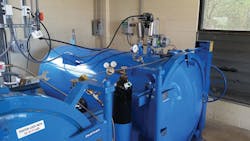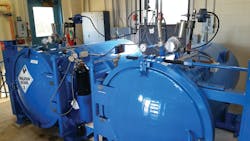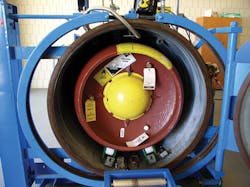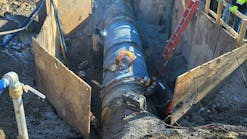Secondary Containment Equipment: Addressing Safety Concerns for Chlorine Gas, Sulfur Dioxide
By Cliff Lebowitz
Superintendents at both a wastewater treatment plant and a drinking water treatment plant have reported long-term, successful deployment of chlorine gas cylinder containment vessels, provided with associated special equipment, to provide enhanced management of gas leak risk, thereby further promoting management’s preference for using chlorine gas as their most cost-effective option for primary disinfection. The same containment apparatus has also been successfully used for other process gas management, such as sulfur dioxide used for dechlorination.
Wastewater Treatment Plant Application
“We are operating 24/7 within 200-300 yards of residences, as well as a youth baseball complex,” noted Wayne Lee, superintendent of the City of Slidell, Louisiana’s 4-MGD wastewater treatment plant, “and we also have a high regard for the safety of our employees. We haven’t had any serious gas leak issues since the plant opened in 1984, and we have a trained hazmat team on call for emergencies, but we were pleased to be able to enhance that response insurance with cost-effective, on-site physical containment readiness.”
It leaves them better prepared for any off-hours event, Lee added, “when there would be only one plant operator, and it would take longer to assemble the hazmat team.”
Plant Operation
The incoming wastewater stream for the design 6 MGD plant passes from the headworks into a grit chamber, followed by two primary clarifiers, aeration tanks, and then final clarifiers that are linked to an anaerobic digestion loop. The clear water leaving the final clarifiers goes to the chlorine contact chamber.
Chlorine is pumped to injectors at the rate of 125 lbs/day, with injection performed at the final clarifiers “to give it more time to work, and also use less that way,” said Lee. He added that gas was his preferred option for chlorine addition since the plant is too big for tablets or powder and bleach would likely cost twice as much.
Two 1-ton cylinders of chlorine are stored in a covered building. Sulfur dioxide, used at the end of the plant process for dechlorination, is stored inside an enclosed building.
Each chlorine and sulfur dioxide cylinder was placed inside a special vessel apparatus in 2010 and 2012, respectively, to contain and process any leaks. These ChlorTainer™ cylinder containment vessels, supplied with loaders, scale systems, and instrumentation, were manufactured by TGO Technologies of Santa Rosa, Calif.
“That vessel containment was much preferred to a scrubber-type solution, which would require major building modifications,” Lee noted. “A scrubber system would also have required a special six-member, trained response team to be available to deal with a leak within the building.”
“With the vessels, it is all done automatically, with minimal personal exposure. And with two tanks for each gas, we don’t have to suffer any plant process interruption if there is leak containment going on in one of them.”
Leak Containment
Lee said the procedures for leak management were not difficult and that the container manufacturer was very helpful with training. “We got used to it during some minor episodes that occurred during cylinder deliveries,” he recalled. “They had been placed in the containment, so we just bypassed to the other cylinder while the gas leak was vacuumed out.”
The containment vessels were positioned on a concrete pad and bolted down. With any accidental leaks of chlorine kept within the containment vessel, no atmospheric venting is generated. The vessels are ASME-rated pressure tanks and any leaks are recycled to the injection system at a normal flow rate. A failsafe valve ties into the chlorine sensor, so that in the event of an external release, the failsafe valve will close and sense it is under vacuum.
Any leak or release of chlorine gas from the vacuum line downstream of a vacuum regulator will compromise the vacuum condition and cause the vacuum regulator to close, stopping the flow of chlorine gas to the vacuum line. The maximum release of chlorine gas will be the amount of chlorine gas that is the length of the vacuum line to the chlorine injector and not drawn into the water solution by the suction of the injector.
There can be a question of the integrity of the system from the outlet line, where chlorine gas penetrates the wall of the pressure vessel, to the location where the vacuum line leaves the outlet side of the pressure regulator. A study has shown this could release less than 0.0009 lbs of chlorine gas. Should there be a gas leak inside a vessel, there is no waste, as the gas is processed at a normal rate until everything is used.
Water Treatment Plant Application
At a 12-MGD water treatment plant (WTP) operated by the City of Benicia, Calif., Superintendent Scott Rovanpera reports that abandoning a plan to switch from chlorine gas to bleach for primary disinfection was enabled through a well-engineered risk management plan for any gas leak risk, thereby allowing him to continue receiving much appreciated benefits from using gas.
“When I started here in 1997, there was already a design engineering study underway toward installing a sodium hypochlorite (bleach) system to replace chlorine gas,” recalled Rovanpera.
“But I knew of significant problems with using sodium hypochlorite in a treatment plant nearby; it was leaking at pipe unions and ball valves,” he noted. “I also saw that our location was in a rural area of north Benicia, with few people anywhere within a mile of the plant, thereby creating a huge buffer in the event of a gas leak.” Rovanpera added that there hadn’t been a major gas leak since the plant opened in 1971; just a few minor ones with transfer hoses when storage tanks were changed.
“We also much appreciated the chlorine gas as an exceptionally strong oxidant that could break down the walls of bacteria and viruses, and it was far less expensive than ozone,” he continued. “Chlorine gas is the least expensive chemical we purchase; it is 100 percent pure, and 2,000 lbs will last up to 25 days during the winter months.”
According to Rovanpera, chlorine was being dosed at 0.6-0.8 mg/L as a pre-oxidant to support enhanced coagulation using aluminum sulfate, thus allowing staff to treat total organic carbon (TOC) levels ranging from 4 to 18 mg/L. “For that need, we were better off with chlorine gas that could depress the pH to assist in the removal of color.” Sodium hypochlorite, which is alkaline, has a tendency to raise the pH during pretreatment. “That also helped us deal with the enhanced coagulation part of EPA’s 1986 Surface Water Treatment Rule,” he explained.
“Our State Water Project (SWP) source water contains high levels of natural organic material (NOM) following storm events,” Rovanpera noted. The challenge of the Enhanced Surface Water Treatment Rule is to reduce the NOM precursors that form disinfection byproducts (DBPs) when disinfecting with chlorine gas or bleach. “DBPs are heavily regulated, and this is the major issue we have to deal with when treating SWP source water,” he explained. “We find that using chlorine gas as a pre-oxidant greatly assists in the coagulation of these precursors.”
Enhancing Leak Risk Management
Chlorine gas is a heavily regulated chemical, and the use of it requires a mandated risk management program (RMP). “So instead of moving away from gas, we moved toward finding ways to make the changing of our 1-ton chlorine cylinders a safer operation for our employees,” he stated.
“We located a company that builds a containment vessel for 1-ton chlorine containers,” he recalled. “The first generation of this secondary containment system utilized a hinged door, with an 18-nut locking system. Tightening those 18 nuts seemed rather labor intensive for our disinfection program. We average a chlorine container change out every two weeks in the summer, so this locking system would have been cumbersome,” he said.
Rovanpera and his team worked with the manufacturer, TGO Technologies, to change to a two-bolt version operated by a jack-screw drive system. Similar to a submarine hatch, the ChlorTainer’s locking mechanism is based on a wheel-operated drive chain that closes two clamshells around the door.
“That innovation resolved our problem,” he concluded, “and led to us changing our course of action in 1998-99 to establish a secondary containment system using a pressure-tight vessel design rather than building a bleach delivery system that would’ve cost us twice as much. Our containment system effectively seals any potential chlorine releases in a secure and leak-proof vessel.”
Leak Containment
The containment system and its conveyor racks were simply positioned on a concrete pad and bolted down. Vacuum breaker regulators are attached for fail-safe shutdown if there is a leak downstream from the containment vessel.
The vessels are designed for not less than 40 years of service. They enclose chlorine gas cylinders, the chlorine transfer hose, and seismic lock-down brackets that prevent the cylinders from moving during an earthquake.
A 1-ton chlorine container is pushed into the secondary containment vessel on rollers. The chlorine transfer hose is attached to the supply valve, pressurized, and tested for any leaks at the hose ends. Then the door is closed and secured by the clamshell locking mechanism.
Operators switch from the standby containment vessel by opening the vacuum breaker valve. The switch-over is performed by a single operator and does not require the wearing of a self-contained breathing apparatus.
To test for leaks within the containment vessel, there are valved ports that can be opened for testing for chlorine gas. If a leak is discovered within the containment vessel, the operator can withdraw the chlorine gas through a vacuum line that delivers the gas into the treatment process. Thus, not only are chlorine gas leaks contained within the containment vessel but the gas can also be extracted and delivered via the typical chlorine feed system.
About the Author: Cliff Lebowitz heads Catalytic Reporting LLC, which specializes in third-party case history reporting for industrial equipment manufacturers. Reporting is based on interviews of end users and is approved by them for accuracy and completeness.






